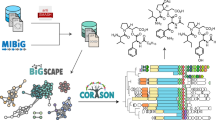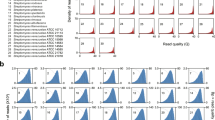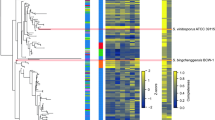Abstract
Genome analysis of actinomycetes has revealed the presence of numerous cryptic gene clusters encoding putative natural products1,2. These loci remain dormant until appropriate chemical or physical signals induce their expression. Here we demonstrate the use of a high-throughput genome scanning method to detect and analyze gene clusters involved in natural-product biosynthesis. This method was applied to uncover biosynthetic pathways encoding enediyne antitumor antibiotics in a variety of actinomycetes. Comparative analysis of five biosynthetic loci representative of the major structural classes of enediynes reveals the presence of a conserved cassette of five genes that includes a novel family of polyketide synthase (PKS)3,4. The enediyne PKS (PKSE) is proposed to be involved in the formation of the highly reactive chromophore ring structure (or “warhead”) found in all enediynes3,4. Genome scanning analysis indicates that the enediyne warhead cassette is widely dispersed among actinomycetes. We show that selective growth conditions can induce the expression of these loci, suggesting that the range of enediyne natural products may be much greater than previously thought. This technology can be used to increase the scope and diversity of natural-product discovery.
This is a preview of subscription content, access via your institution
Access options
Subscribe to this journal
Receive 12 print issues and online access
$209.00 per year
only $17.42 per issue
Buy this article
- Purchase on Springer Link
- Instant access to full article PDF
Prices may be subject to local taxes which are calculated during checkout



Similar content being viewed by others
References
Bentley, S.D. et al. Complete genome sequence of the model actinomycetes Streptomyces coelicolor A3(2). Nature 417, 141–147 (2002).
Omura, S. et al. Genome sequence of an industrial microorganism Streptomyces avermitilis: deducing the ability of producing secondary metabolites. Proc. Natl. Acad. Sci. USA 98, 12215–12220 (2001).
Liu, W. Christenson, S.D., Standage, S. & Shen, B. Biosynthesis of the enediyne antitumor antibiotic C-1027. Science 297, 1170–1173 (2002).
Ahlert, J. et al. The calicheamicin gene cluster and its iterative type I enediyne PKS. Science 297, 1173–1176 (2002).
Martin, J.F. & Liras, P. Organization and expression of genes involved in the biosynthesis of antibiotics and other secondary metabolites. Annu. Rev. Microbiol. 43, 173–206 (1989).
Beyer, S., Distler, J. & Piepersberg, W. The str gene cluster for the biosynthesis of 5′-hydroxystreptomycin in Streptomyces glaucescens GLA.0 (ETH 22794): new operons and evidence for pathway-specific regulation by StrR. Mol. Gen. Genet. 250, 775–784 (1996).
Schwecke, T. et al. The biosynthetic gene cluster for the polyketide immunosuppressant rapamycin. Proc. Natl. Acad. Sci. USA 92, 7839–7843 (1995).
Doyle, T.W. & Borders, D.B. Enediyne antitumor antibiotics. in Enediyne Antibiotics as Antitumor Agents (eds. Borders, D.B. & Doyle, T.W.) 1–15 (Marcel Dekker, New York, 1995).
Smith, A.L. & Nicolaou, K.C. The enediyne antibiotics. J. Med. Chem. 39, 2103–2117 (1996).
Walsh, C.T., Gehring, A.M., Weinreb, P.H., Quadri, L.E. & Flugel, R.S. Post-translational modification of polyketide and nonribosomal peptide synthases. Curr. Opin. Chem. Biol. 1, 309–315 (1997).
Benning, M.M. et al. The three-dimensional structure of 4-hydroxybenzoyl-CoA thioesterase from Pseudomonas sp. Strain CBS-3. J. Biol. Chem. 273, 33572–33579 (1998).
Elespuru, R.K. & Yarmolinsky, M.B. A colorimetric assay of lysogenic induction designed for screening potential carcinogenic and carcinostatic agents. Environ. Mutagen. 1, 65–78 (1979).
Maeda, H. The clinical effects of neocarzinostatin and its polymer conjugate, SMANCS. in Enediyne Antibiotics as Antitumor Agents (eds. Borders, D.B. & Doyle, T.W.) 363–380 (Marcel Dekker, New York, 1995).
Sievers, E.L. & Lineberger M. Mylotarg: antibody-targeted chemotherapy comes of age. Curr. Opin. Oncol. 13, 522–527 (2001).
Brukner, I. C-1027 Taiho Pharmaceutical Co. Ltd. Curr. Opinion Oncologic, Endocrine & Met. Invest. Drugs 2, 344–352 (2000).
Chater, K.F. & Bibb, M.J. Regulation of bacterial antibiotic production. In Biotechnology vol. 7: Products of Secondary Metabolism (eds. Kleinkauf, H. & von Döhren, H.) 57–105 (VCH Press, Weinheim, Germany, 1997).
Kieser, T., Bibb, M.J., Buttner, M.J., Chater, K.F. & Hopwood, D.A. Practical Streptomyces Genetics (The John Innes Foundation, Norwich, UK, 2000).
Kelley, L.A., MacCallum, R.M. & Sternberg M.J. Enhanced genome annotation using structural profiles in the program 3D-PSSM. J. Mol. Biol. 299, 499–520 (2000).
Reuter, K., Mofid, M.R., Marahiel, M.A. & Ficner, R. Crystal structure of the surfactin synthetase-activating enzyme Sfp: a prototype of the 4′-phosphopantetheinyl transferase superfamily. EMBO 18, 6823–6831 (1999).
Kumada, Y. et al. A degradation product of the chromophore of auromomycin. J. Antibiot. (Tokyo) 36, 200–202 (1983).
Acknowledgements
We thank S. Mercure, V. Dodelet, and M. Piraee for helpful discussions and J. McAlpine for critical reading of the manuscript. B.S. is a recipient of a NSF CAREER Award (MCB9733938) and a NIH Independent Scientist Award (AI51689). Enediyne studies in the Shen lab are supported in part by NIH grant CA78747. Research in the Thorson lab is supported in part by NIH grants CA84347, GM58196, and AI52218. J.S.T. is an Alfred P. Sloan Fellow.
Author information
Authors and Affiliations
Corresponding author
Ethics declarations
Competing interests
The authors declare no competing financial interests.
Supplementary information
41587_2003_BFnbt784_MOESM1_ESM.pdf
Supplementary Fig. 1. Amino acid alignment of the PKSE family of proteins. Approximate boundaries of domains are indicated above the alignment; KS, ketosynthase domain; AT, acyl transferase domain; ACP, acyl carrier protein domain; KR, ketoreductase domain; DH, dehydratase domain; PPTE, 4'-phosphopantetheinyl transferase domain (described further in Fig. F); domain ?, possible domain. Key residues involved in cofactor binding or catalysis are highlighted in black (Kakavas et al. Identification and characterization of the niddamycin polyketide synthase genes from Streptomyces caelestis. J Bacteriol. 179, 7515-7522 (1997); Fisher et al. The X-ray structure of Brassica napus beta-keto acyl carrier protein reductase and its implications for substrate binding and catalysis. StructureFold Des. 8, 339-347 (2000)). (PDF 51 kb)
41587_2003_BFnbt784_MOESM3_ESM.pdf
Supplementary Fig. 3. Amino acid alignment of the UNBL family of proteins. PSORT (Nakai K, and Horton P. PSORT: a program for detecting sorting signals in proteins and predicting their subcellular localization. Trends Biochem Sci. 24, 34-36 (1999)) analysis predicts this family to be cytosolic with high confidence. (PDF 26 kb)
41587_2003_BFnbt784_MOESM4_ESM.pdf
Supplementary Fig. 4. Amino acid alignment of the UNBU family of proteins. PSORT analysis predicts this family to be integral membrane proteins with high confidence. The predicted transmembrane-spanning regions are highlighted. (PDF 31 kb)
41587_2003_BFnbt784_MOESM5_ESM.pdf
Supplementary Fig. 5. Amino acid alignment of the UNBV family of proteins. PSORT analysis predicts this family to be secreted proteins with high confidence. Fifteen of the sixteen UNBV members are predicted to have an N-terminal signal sequence and of these, only that from the 059A cassette is not predicted to be cleavable. (PDF 31 kb)
41587_2003_BFnbt784_MOESM6_ESM.pdf
Supplementary Fig. 6. Alignment of the PPTE domains of the warhead polyketide synthase with the Sfp 4'-phosphopantetheinyl transferase of B.subtilis. For the purpose of comparison, the amino acid numbering scheme of the Sfp protein is used to refer to corresponding residues in the PPTE domains. Predicted secondary structure elements found in the PPTE domains are shown above the alignments, while structural elements found in the X-ray crystal structure of the Sfp protein are shown below the alignments (Reuter et al. Crystal structure of the surfactin synthetase-activating enzyme Sfp: a prototype of the 4'-phosphopantetheinyl transferase superfamily. EMBO 18, 6823-6831 (1999). (PDF 182 kb)
Rights and permissions
About this article
Cite this article
Zazopoulos, E., Huang, K., Staffa, A. et al. A genomics-guided approach for discovering and expressing cryptic metabolic pathways. Nat Biotechnol 21, 187–190 (2003). https://doi.org/10.1038/nbt784
Received:
Accepted:
Published:
Issue Date:
DOI: https://doi.org/10.1038/nbt784
This article is cited by
-
Isolation and identification of marine microbial products
Journal of Genetic Engineering and Biotechnology (2021)
-
Precursor-feeding and altered-growth conditions reveal novel blue pigment production by Rubrivivax benzoatilyticus JA2
Biotechnology Letters (2019)
-
A dual role for a polyketide synthase in dynemicin enediyne and anthraquinone biosynthesis
Nature Chemistry (2018)
-
Bioprospecting potential of halogenases from Arctic marine actinomycetes
BMC Microbiology (2016)



